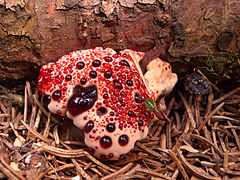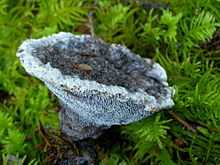Hydnellum
| Hydnellum | |
|---|---|
 | |
| Hydnellum peckii | |
| Scientific classification | |
| Kingdom: | Fungi |
| Division: | Basidiomycota |
| Class: | Agaricomycetes |
| Order: | Thelephorales |
| Family: | Bankeraceae |
| Genus: | Hydnellum P.Karst. (1879) |
| Type species | |
| Hydnum suaveolens Scop. (1772) | |
| Synonyms[1] | |
|
Calodon Quél. ex P.Karst. (1881)[2] | |
Hydnellum is a genus of tooth fungi of the family Bankeraceae in the order Thelephorales. The genus is widely distributed, and contains an estimated 38 species.[4] The fruit bodies of its members grow by slowly enveloping bits of grass and vegetation around them. They are too tough and woody to eat comfortably. Several species have become the focus of increasing conservation concern following widespread declines in abundance.[5][6]
Some species of Hydnellum produce pigments that have been used for centuries to dye textiles.[7]
One of the better-known species is the unusual pinkish-white species Hydnellum peckii, also known as "strawberries and cream" or as the "bleeding tooth fungus" due to the red droplets that appear on the pinkish or whitish fruit bodies.[8] Another species, H. suaveolens, has a strong odor of anise or peppermint.[8]
The name comes the Greek hydnum meaning spongy plant or fungus.[9]
Description
Hydnellum fruit bodies have caps and stems, often with indeterminant growth forms, that may grow in spurts and decay over several weeks. The flesh has a zoned appearance and is fibrous when fresh, hard and woody when dry. The spines are crowded and typically decurrent, and may be a variety of colors, such as white to yellow, olive green, shades of orange, light brown, or dark brown in age. The spores are almost spherical to oblong and tuberculate, and are brown in mass.[10]
All are too tough and woody to be edible, and many have an acrid taste anyway.[8]
2000s developments
In the 2000s, techniques based on species-specific PCR primers and DNA extraction from soil have been developed to detect the mycelia of various Hydnellum species without having to rely on the presence of fruit bodies, which may help conservation efforts as well as improve understanding of below-ground ecology.[11]
Species

- Hydnellum aurantiacum
- Hydnellum auratile
- Hydnellum caeruleum
- Hydnellum chrysinum
- Hydnellum coalitum
- Hydnellum compactum
- Hydnellum complicatum
- Hydnellum concrescens
- Hydnellum cristatum
- Hydnellum cruentum
- Hydnellum crustulinum
- Hydnellum cumulatum
- Hydnellum cyanodon
- Hydnellum cyanopodium
- Hydnellum earlianum
- Hydnellum ferrugineum
- Hydnellum fraudulentum
- Hydnellum frondosum
- Hydnellum geogenium
- Hydnellum gracilipes
- Hydnellum mirabile
- Hydnellum multiceps
- Hydnellum nigellum
- Hydnellum papuanum
- Hydnellum peckii
- Hydnellum regium
- Hydnellum scleropodium
- Hydnellum scrobiculatum
- Hydnellum septentrionale
- Hydnellum singeri
- Hydnellum spongiosipes
- Hydnellum staurastrum
- Hydnellum suaveolens
- Hydnellum subzonatum
- Hydnellum tardum
References
- ↑ "Hydnellum P. Karst. 1879". MycoBank. International Mycological Association. Retrieved 2012-03-25.
- ↑ Karsten PA. (1881). "Enumeratio Hydnearum Fr. Fennicarum, systemate novo dispositarum". Revue mycologique, Toulouse (in Latin) 3 (9): 19–21.
- ↑ Schröter J. (1888). Kryptogamen-Flora von Schlesien. 3–1(4). p. 458.
- ↑ Kirk PM, Cannon PF, Minter DW, Stalpers JA. (2008). Dictionary of the Fungi (10th ed.). Wallingford, UK: CAB International. p. 324. ISBN 978-0-85199-826-8.
- ↑ Newton AC, Holden E, Davy LM, Ward SD, Fleming LV, Watling R. (2002). "Status and distribution of stipitate hydnoid fungi in Scottish coniferous forests". Biological Conservation 107 (2): 181–92. doi:10.1016/S0006-3207(02)00060-5.
- ↑ Parfitt D, Ainsworth AM, Simpson D, Rogers HJ, Boddy L. (2007). "Molecular and morphological discrimination of stipitate hydnoids in the genera Hydnellum and Phellodon". Mycological Research 111 (7): 761–77. doi:10.1016/j.mycres.2007.05.003. PMID 17681224.
- ↑ Westmoreland S, Volk TJ. (2001). "A preliminary study of Hydnellum (Thelephoraceae, Basidiomycota) using morphological and pigment characteristics". Phytopathology 91 (6): S126.
- ↑ 8.0 8.1 8.2 Arora, David (1986). Mushrooms Demystified. Berkeley, California: Ten Speed Press. pp. 623–27. ISBN 0-89815-169-4.
- ↑ Gamiet S, Berch SM, Kroeger P, Roberts C, Winder R, MacKinnon A. "Welcome to BC NTFP Mushrooms". BC NTFP mushrooms. Southern Interior Forest Extension and Research Partnership. Retrieved 2010-02-12.
- ↑ Baird RE, Khan SR. (1986). "The stipitate Hydnums (Thelephoraceae) of Florida USA". Brittonia 38 (2): 171–84. JSTOR 2807273.
- ↑ van der Linde S, Alexander I, Anderson IC. (2008). "A PCR-based method for detecting the mycelia of stipitate hydnoid fungi in soil". Journal of Microbiological Methods 75 (1): 40–46. doi:10.1016/j.mimet.2008.04.010. PMID 18586344.
External links